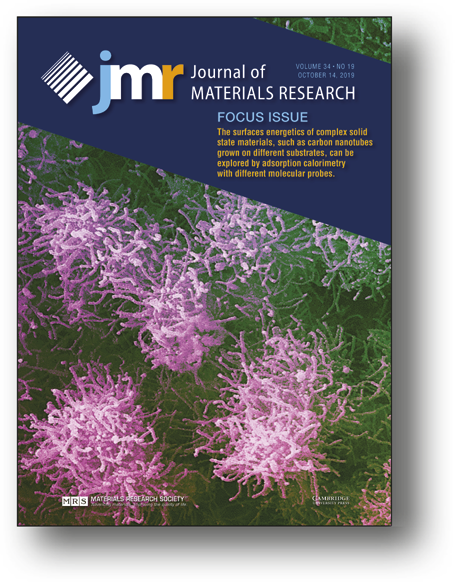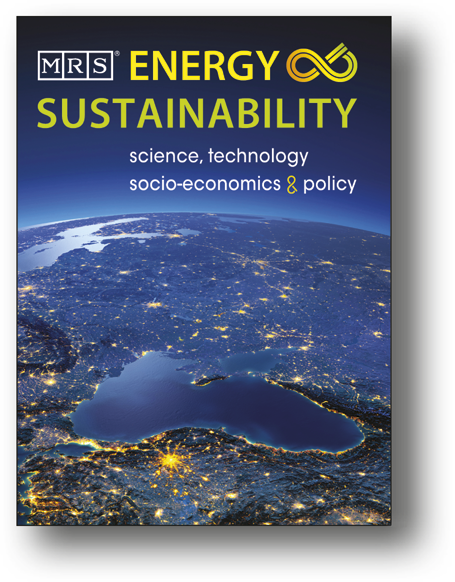
Crystal growth and structural analysis of perovskite chalcogenide BaZrS3 and Ruddlesden–Popper phase Ba3Zr2S7
Shanyuan Niu, Boyang Zhao, Kevin Ye, Elisabeth Bianco, Jieyang Zhou, Michael E. McConney, Charles Settens, Ralf Haiges, Rafael Jaramillo, Jayakanth Ravichandran
Perovskite chalcogenides are emerging semiconductors for optoelectronic applications. The authors report flux crystal growth of BaZrS3 and its Ruddlesden–Popper phase Ba3Zr2S7. Full width at half maximums of 0.011° for BaZrS3 and 0.027° for Ba3Zr2S7 were determined by pole figure analysis. Scanning transmission electron microscopy and electron diffraction patterns establish the grown crystals are of high quality. The octahedral tilting in the corner-sharing octahedral network was analyzed by extracting the torsion angles. doi.org/10.1557/jmr.2019.348
Understanding the driving forces for crystal growth by oriented attachment through theory and simulations
Maria L. Sushko
Oriented attachment (OA) is a particle-based crystallization pathway in which nanocrystals self-assemble in solution and attach along certain crystallographic direction, often forming highly organized three-dimensional crystal morphologies. A theoretical framework for modeling crystallization by OA is reviewed and underscores the importance of solvent-mediated forces that drive nanocrystal reorientation and alignment for face-selective attachment. The findings demonstrate the importance of interfacial solvent structure and dynamics for OA research. doi.org/10.1557/jmr.2019.151
A new nanoindentation creep technique using constant contact pressure
Olena Prach, Christian Minnert, Kurt E. Johanns, Karsten Durst
A new constant contact pressure (CCP) indentation creep method is presented. Besides controlling the mean contact pressure, the dynamic stiffness is used to assess the indentation depth, thereby minimizing thermal drift influence and pile-up or sink-in effects during long-term experiments. The CCP method is demonstrated for strain rate sensitive ultrafine-grained (UFG) CuZn30 and UFG CuZn5, as well as on fused silica with strain rates from 5 × 10−4 s−1 down to 5 × 10−6 s−1. doi.org/10.1557/jmr.2019.188

Impact of modularity as a circular design strategy on materials use for smart mobile devices
Karsten Schischke, Marina Proske, Nils F. Nissen, Martin Schneider-Ramelow
Most of the environmental life-cycle impacts of current mobile devices are related to high-tech manufacturing processes, such as semiconductor manufacturing and printed circuit board processing. This work showcases that modularity is an appropriate approach for a circular design, but lifetime extension of functional devices and parts is the most promising strategy to reduce the overall environmental footprint. doi.org/10.1557/mre.2019.17
An ode to polyethylene
Svetlana V. Boriskina
Most references to “polyethylene” are in the nature of “the current level of environmental plastic pollution is unsustainable.” Polyethylene does comprise a large volume of plastic waste because it is used in so many different products. There are, however, good reasons why polyethylene is one of the most-produced materials in the world, and this review discusses various useful applications stemming from its unique material properties. doi.org/10.1557/mre.2019.15
High-rate lithium-ion energy storage to facilitate increased penetration of photovoltaic systems in electricity grids
Alison Lennon, Yu Jiang, Charles Hall, Derwin Lau, Ning Song, Patrick Burr, Clare P. Grey, Kent J. Griffith
Energy storage for large grid scale has been the “holy grail” for the energy materials research community. High-rate lithium-ion batteries with ultra-long cycling lives (>10,000 cycles) can provide electricity grid stabilization services in the presence of large fractions of intermittent generators, such as photovoltaics. doi.org/10.1557/mre.2019.4





